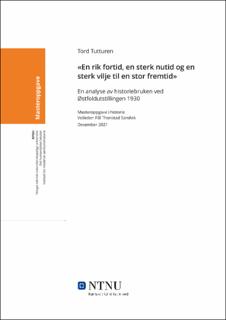| dc.contributor.advisor | Sandvik, Pål Thonstad | |
| dc.contributor.author | Tutturen, Tord | |
| dc.date.accessioned | 2022-03-02T18:19:46Z | |
| dc.date.available | 2022-03-02T18:19:46Z | |
| dc.date.issued | 2021 | |
| dc.identifier | no.ntnu:inspera:95129660:37180520 | |
| dc.identifier.uri | https://hdl.handle.net/11250/2982638 | |
| dc.description.abstract | Østfoldutstillingen var fylkesutstilling i Sarpsborg sommeren 1930 som skulle vise hele fylkets stilling på nærmest alle områder. Utstillingen må forstås i en utstillingstradisjon som spenner fra verdensutstillinger til rurale, norske landbruksutstillinger. Siden Østfoldutstillingen var farget av sin tid og kan betraktes som en avspeiling av samtidens historiebevissthet, brukes utstillingen som et prisme for å innsikt i samtidens holdninger til fortid, tradisjon og fremtid. I den kulturhistoriske avdelingen av utstillingen hadde historie en egenverdi ettersom den hadde en stolthetsskapende og bevisstgjørende funksjon. Avdelingens fortelling er i tråd med en stolt, nasjonal historie, men med et nyansert syn på foreningstiden. På Hovedutstillingen ble historiske elementer brukt retorisk for å skape kontrast mellom fortid og nåtid, og for å understreke historiens gang som en fremskrittsfortelling. Utstillingen kommuniserte en nøktern fremtidsvisjon og pekte mot en fremtid med elektriske bekvemmeligheter på mange områder. Utstillingens historiske forankring viser at historie og tradisjon hadde relevans og verdi i samtiden, et trekk vi også finner ved andre utstillinger og i samfunnet for øvrig i mellomkrigstiden. | |
| dc.description.abstract | The Østfold Exhibition was a regional exhibition held in Sarpsborg in the summer of 1930, with an ambition to show the level of progress in most areas. The exhibition is a part of a larger tradition which spans from World Fairs to rural Norwegian agricultural exhibitions. This dissertation utilises that the exhibition was shaped by its time and mirrors the historical consciousness of its time, to use the exhibition as a prism to explore contemporary attitudes to the past, tradition, and the future. In the Historical Section of the exhibition, history had value in itself because of its function of fuelling pride and creating awareness. The section’s narrative was in line with a tradition of a proud, national history, although with a nuanced view of the Dano-Norwegian union. At the Main Exhibition, historical elements were used rhetorically to create contrast between past and present, and to assert a narrative of progress. The exhibition expressed a prudent view of the future and allured to a future with electrical conveniences in many areas. The exhibition’s historical orientation shows that history and tradition had relevance and value, a trait which can be found at other exhibitions and in society in general in the interwar period. | |
| dc.language | nob | |
| dc.publisher | NTNU | |
| dc.title | «En rik fortid, en sterk nutid og en sterk vilje til en stor fremtid»: En analyse av historiebruken ved Østfoldutstillingen 1930 | |
| dc.type | Master thesis | |
